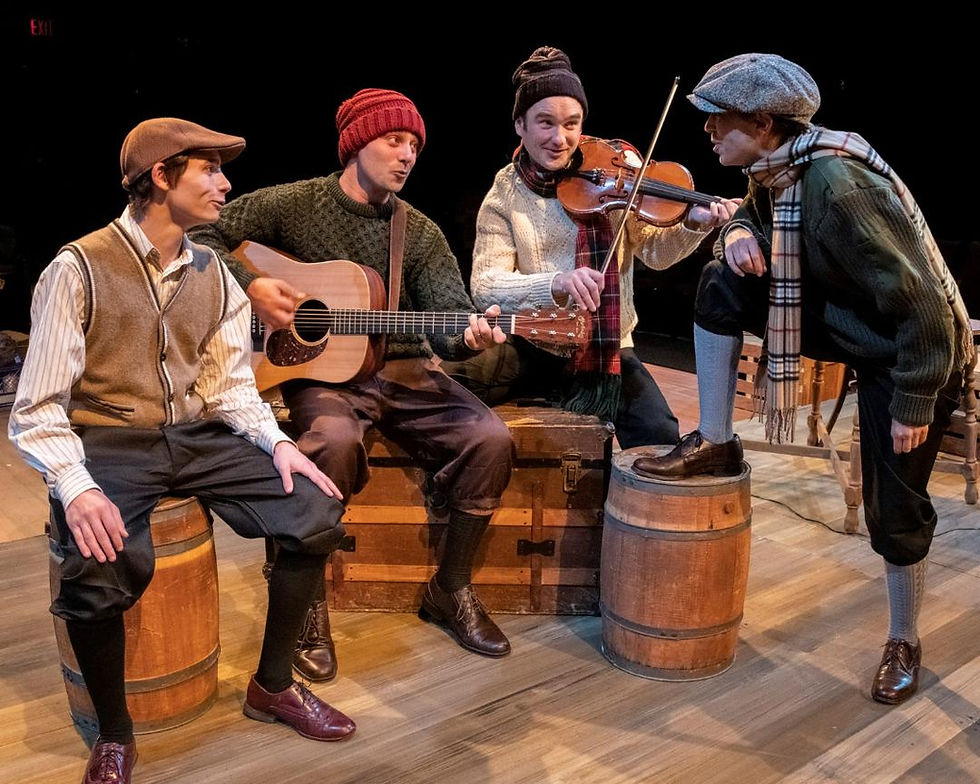A Child's Christmas in Wales
- Anthony Chase

- Nov 30, 2019
- 4 min read
Review by ANTHONY CHASE

A Child’s Christmas in Wales is Dylan Thomas’ idyllic reminiscence of Christmases past, when it always snowed and magic really happened. Under the direction of Chris Kelly, the stage version now at the Irish Classical Theatre Company, adapted by Jeremy Brooks and Adrian Mitchell, captures the nostalgia of the original text and conjures plenty of holiday magic of its own.
Evolving from stories that the Welsh poet read on radio in 1952, just a year before his death at the age of 39, A Child’s Christmas in Wales is a succession of Christmas anecdotes told from the point of view of Thomas as a young boy in Swansea, Wales. A formidable cast of 14 invokes the many characters of Thomas’ memory in all their vivid idiosyncrasy and lovability.
Instead of a dominant narrative thread, the structure simply takes us through Christmas Day, one anecdote at a time.
Vincent O’Neill plays the adult Dylan Thomas, who suggests the unreliability and amplification of memory in evoking Thomas’ famous observation, “I can never remember whether it snowed for six days and six nights when I was twelve or whether it snowed for twelve days and twelve nights when I was six.” Such are the tricks of recollection, located in that space between reality and imagination, in which one Christmas is so much like another, and in which distant, long silent voices speak to us again, a moment before we fall asleep.
Extraordinarily charismatic and unaffected fifteen-year-old Tyler Eisenmann, surrounded by a world of adults who play both adults and children, is Young Dylan. This dynamic heightens the nostalgia with memories of holidays when the divisions between the generations melted away.
Michele Marie Roberts is divine as Young Dylan’s mother, a strict disciplinarian with a soft heart. I especially adored the fuming glares she directs at her husband, played by Ben Michael Moran, when he fails to rescue her from the arms of their postman, tipsy with Christmas cheer, who forces her to dance with him. Roberts’ radiant singing voice is also a distinct asset in this production, which depends on song for much of its energy.
For their parts, Christian Brandjes plays the delightfully inebriated postman, and Ben Michael Moran plays the good-natured, if at times ineffectual husband. Indeed, A Child’s Christmas in Wales convincingly makes family dysfunction look like an advantage, and makes alcoholism look like an appealing quality.
In the latter category, Nicole Cimato goes for broke in the role of Aunt Hannah, successfully staggering her way into our hearts with as happy a drunk routine as you ever will see. The joy is magnified by Roberts’ repeated and unsuccessful attempts to intercept Hannah’s beverages.
Gregory Gjurich and Charmagne Chi represent comical marital disharmony as Uncle Tudyr and aspirin-popping Aunt Bessie. They turn caricatures in to entirely believable people.
There is something fey and ethereal about Megan Callahan’s portrayal of favorite Aunt Elieri, a woman with the capacity to make every child feel special, and the gift of finding magic in life’s most mundane events.
Brittany Bassett and Renee Landrigan evoke memories of limitless childhood irritation as young Dylan’s overly eager and energetic interchangeable cousins, Brenda and Glenda.
The doubling of roles provides numerous opportunity for playful invention and clowning. Among my favorite moments of the show are the appearances of the women of the cast as the tough and fearsome "Town Hill Boys."
In a show that depends on music to evoke Christmas nostalgia, love of home, and momentum, the stronger voices: Roberts, Chi, and Karen Harty, who plays Nellie, are welcome. The show’s opening sequence begins with Brandon Barry and the show’s music director, Joseph Donohue III, accompanying their own pleasing voices with guitar. This sets the tone and gets the festivities off to a happy start.
While the forward impetus of the show flags at times, the overall spirit is cheerful and warm. Actors doubling in roles to populate an entire Welsh town provides seemingly endless opportunities for humor and theatrical invention. Choreography by Bobby Cooke adds cohesiveness.
I am, again bewildered by the seemingly unkillable impulse to clutter the arena style stage of the Andrews Theatre, where the audience surrounds the action on all four sides, with stuff. On this occasion, designer Primo Thomas has provided step levels and has divided the small stage into four quadrants, successfully eliminating the elegant flexibility of the arena space by confining the action into cramped quarters and obstructing every view with crates or furniture. These encumbrances are augmented by the decision to have all the instrumental music performed live, obliging the constant presence of an upright piano, smack at the center of everything, ensuring that no matter where you are seated, everyone else appears to have a better view.
How these decisions, a negotiation between directorial demand and design concept, are made, is unknowable. While the overall look of the stage pictures is appropriate to the style, period, and tone of the piece, sometimes, as architect Ludwig Mies van der Rohe many times observed, less would actually be more.
The magic of holiday time and memories of home will help every audience member overcome the minor imperfections of A Child’s Christmas in Wales, as this capable cast happily launches the start of the holiday season.


